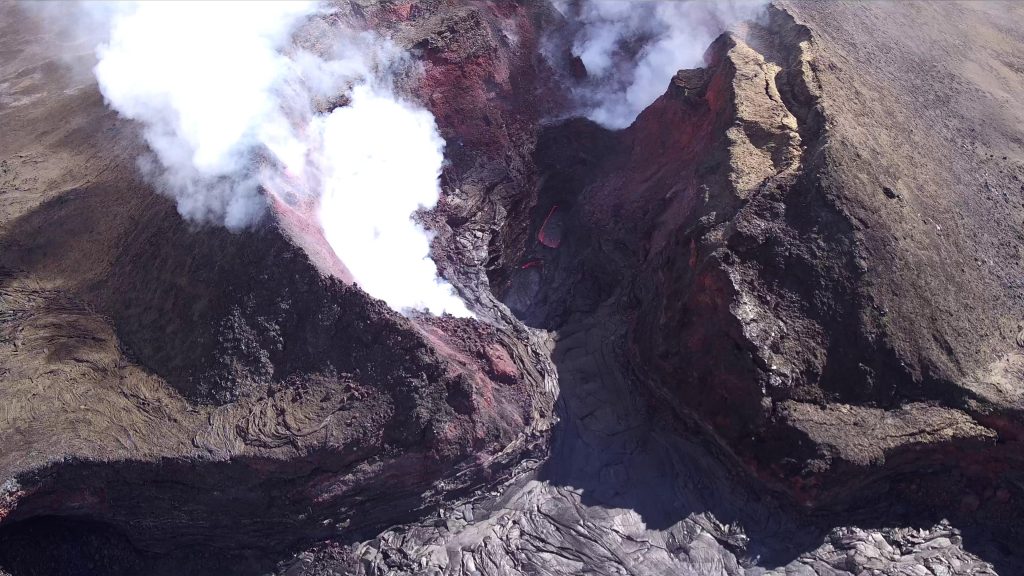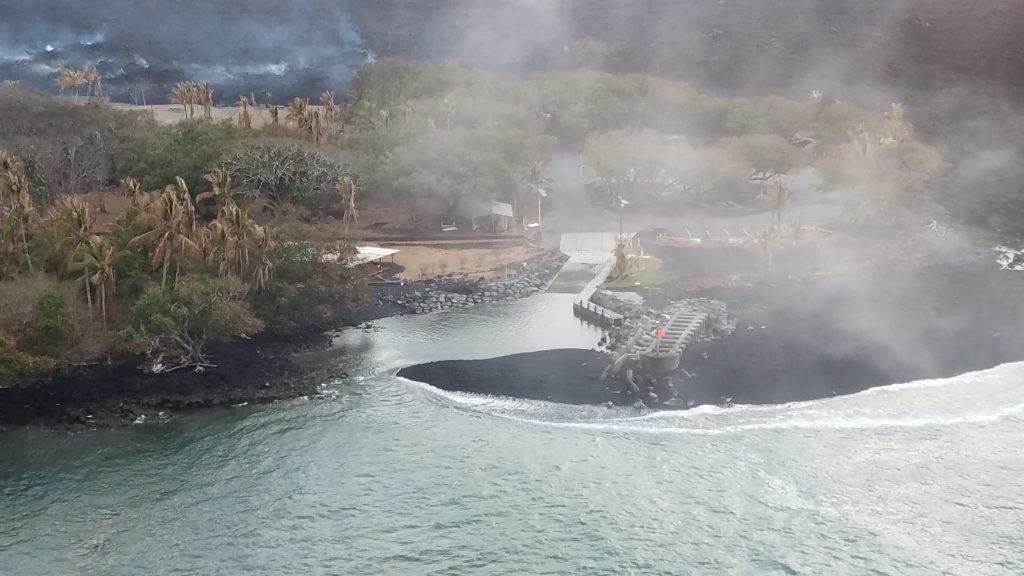Kīlauea Eruption Affects Ocean Microbes & Ecosystem
The University of Hawai‘i at Mānoa reports that a rapid response team of scientists from the University of Hawai‘i at Mānoa’s Center for Microbial Oceanography: Research and Education (C-MORE) in the School of Ocean and Earth Science and Technology returned from a four-day expedition to investigate the effects of the Kīlauea volcanic eruption on marine life near Kapoho on Hawai‘i Island and the surrounding areas.

The UAS team (Unmanned Aircraft Systems) flew a mission over Fissure 8 on Saturday, Aug. 11, 2018, to assess conditions within the cinder cone. As shown, Fissure 8 contains two small ponds deep within its crater. One pond slowly circulates with an incandescent surface while the other pond is stagnant with a crusted top. Click to enlarge. PC: USGS
Understanding the impact of the eruption on ocean microbes is critical to understanding its potential effect on the broader marine ecosystem.
Satellite images revealed elevated chlorophyll levels in the ocean near the eruption zone, indicating a bloom of algae—tiny photosynthetic microbes that absorb carbon dioxide, produce oxygen and serve as the foundation of the marine food web.
“We confirmed the algae bloom, although as usual mother nature also served up some surprises and challenges,” said David Karl, SOEST professor of oceanography and C-MORE director. “We found that the chemistry of the lava interacts with the ocean to provide a nourishment, a fertilizer if you will, and that promoted the growth of plants.”

Close view of the Pohoiki boat ramp during Saturday, Aug. 11, 2018, overflight. The southern-most flow margin has not advanced significantly toward the Pohoiki boat ramp, but black sand and larger fragments from the entry areas have washed ashore to create a sand bar and beach at this site. Geologists observed several small lava streams trickling into the sea along the souther portion of the lava delta, producing weak laze plumes. Click to enlarge. PC: USGS
The researchers theorize that the lava and ash, which are enriched in iron and phosphorus, are acting as a fertilizer fueling the algae growth.Onboard the UH research vessel Ka‘imikai-O-Kanaloa, researchers sampled the water and will study its contents to discover how the volcanic eruption and ocean entry are influencing ocean chemistry, phytoplankton activities and ecosystem processes.
“The water samples are currently being analyzed at laboratories around the world,” said Karl, who said the team of researchers also conducted experiments to measure the productivity of the algae and more. “The cruise was a huge success.”
Although lava output from fissure 8 remains low, the ocean entry was still active during HVO’s helicopter overflight on Aug. 9, 2018. VC: USGS
The team also successfully deployed a WaveGlider and a SeaGlider, two types of drones that will be surveying the region for the next few months.
Often, research cruises are planned years in advance. In this case, rapid deployment was necessary because phytoplankton blooms, like the one captured in the satellite images, are short-lived.
Karl and team quickly coordinated with Jackie Caplan-Auerbach, a Western Washington University researcher and SOEST alumna, who had a cruise planned to deploy a series of ocean bottom seismometers near the shoreline.
The UH Mānoa team also received funds for ship time from the National Science Foundation and the Simons Foundation, which also supports the Simons Collaboration on Ocean Processes and Ecology, a cross-disciplinary effort to measure and model the critical activities of marine microbes based at UH Mānoa.
The team will continue to gain insight into the effect of this rare interaction. In late July, the U.S. National Science Foundation awarded Karl and SOEST Oceanography Professor Edward DeLong more than $180,000 to advance this work. With the new grant, the team will return to the field to recover the drones, and gather additional observations and water samples at the lava-seawater contact zone and in the ash deposition region downwind of Halema‘uma‘u in west Hawai‘i Island.
They will also use ash samples in future laboratory and field-based experiments to determine the acute effects on the growth and metabolism of marine microbes.
Researchers at UH Hilo are also hard at work collecting data at the eruption site, using seafaring robots to study lava entering the ocean.
















